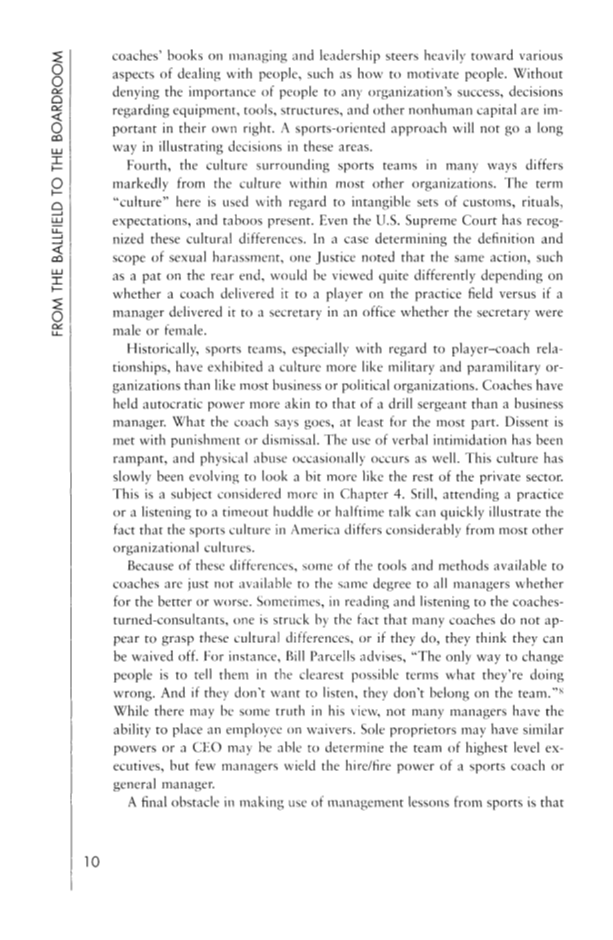coaches' books on managing and leadership steers heavily toward various aspects of dealing with people, such as how to motivate people. Without denying the importance of people to any organization's success, decisions regarding equipment, tools, structures, and other nonhuman capital are im- portant in their own right. A sports-oriented approach will not go a long way in illustrating decisions in these areas. Fourth, the culture surrounding sports teams in many ways differs markedly from the culture within most other organizations. The term "culture" here is used with regard to intangible sets of customs, rituals, expectations, and taboos present. Even the U.S. Supreme Court has recog- nized these cultural differences. In a case determining the definition and scope of sexual harassment, one Justice noted that the same action, such as a pat on the rear end, would be viewed quite differently depending on whether a coach delivered it to a player on the practice field versus if a manager delivered it to a secretary in an office whether the secretary were male or female. Historically, sports teams, especially with regard to player-coach rela- tionships, have exhibited a culture more like military and paramilitary or- ganizations than like most business or political organizations. Coaches have held autocratic power more akin to that of a drill sergeant than a business manager. What the coach says goes, at least for the most part. Dissent is met with punishment or dismissal. The use of verbal intimidation has been rampant, and physical abuse occasionally occurs as well. This culture has slowly been evolving to look a bit more like the rest of the private sector. This is a subject considered more in Chapter 4. Still, attending a practice or a listening to a timeout huddle or halftime talk can quickly illustrate the fact that the sports culture in America differs considerably from most other organizational cultures. Because of these differences, some of the tools and methods available to coaches are just not available to the same degree to all managers whether for the better or worse. Sometimes, in reading and listening to the coaches- turned-consultants, one is struck by the fact that many coaches do not ap- pear to grasp these cultural differences, or if they do, they think they can be waived off. For instance, Bill Parceiis advises, "The only way to change people is to tell them in the clearest possible terms what they're doing wrong. And if they don't want to listen, they don't belong on the team."8 While there may be some truth in his view, not many managers have the ability to place an employee on waivers. Sole proprietors may have similar powers or a CEO may be able to determine the team of highest level ex- ecutives, but few managers wield the hire/fire power of a sports coach or general manager. A final obstacle in making use of management lessons from sports is that 10
Document Details My Account Print multiple pages
Print
You have printed 0 times in the last 24 hours.
Your print count will reset on at .
You may print 0 more time(s) before then.
You may print a maximum of 0 pages at a time.
































































































































































































































































